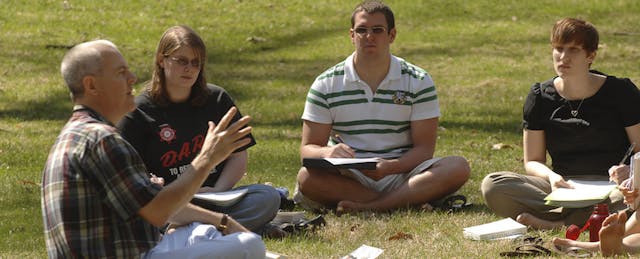With the arrival of MOOCs, many people—especially the media—began to question the value of a traditional, residential college experience. After all, if a student can take MIT’s engineering MOOC for free, or Stanford’s computer science MOOC for a low cost, why pay (tens of) thousands of dollars a year, over four years?
Typical responses from the academy centered on the value of credentialing, formalized assessment, the maturation process associated with living on one’s own, and the building of possible lifelong connections. Without a doubt, these are all valuable parts of the traditional college experience. However, I believe they miss the specific value that can be reaped from a physical classroom experience: the opportunity to learn with, through and about others.
Delivering this benefit in the classroom is not easy. It requires faculty to rethink how they spend class time and cede some amount of structure and control. It further requires real interaction between students in class, when these same students have become accustomed to interacting primarily through online media. But it is precisely this preference that I think we can turn to our advantage. Let students learn the fundamental building blocks from online material, but do so outside of the classroom. Then, use class-time to work on complex, real-world, group-oriented problems. In short, make the classroom about experiential learning.
Learning Through Experience
Today’s real-world problems demand multi-faceted thinking and solutions. The complexity and nuance make group work necessary. It is difficult for one person (particularly a student with limited real-world experience), to conceive of every angle in such challenges. But it is the process of group work that contains the “hidden” value. It offers the opportunity to observe others’ thought processes, perspectives, values and judgments.
By working together in a diverse group, students must be able to speak to others’ viewpoints. They must figure out how to work through arguments. They have to compromise and reach consensus. These all matter for success in both life and work. Today’s global society and economy demand that an understanding of and comfort with diverse viewpoints, personalities and cultural differences is necessary.
There are additional advantages to this classroom approach. Employers often say the most difficult qualities to find (and therefore the most highly valued) are: the ability to think critically and creatively; to collect, sift and clean data; to hypothesize, test and infer; to work with others; and to communicate effectively. Spending class-time on experiential learning, conducted in small groups of students, can enhance each of these skills. Students ask questions and make mistakes in smaller, safer-feeling environments. Learning by making mistakes and working through them also replicates real-world experiences better than a more traditional college experience (of handing in homework and having it handed back marked right or wrong).
But if knowledge transfer can happen outside of class, and if the in-class experience is focused on experiential and peer-to peer learning, where does the professor fit in? Does this kind of classroom experience make faculty less relevant?
The New Role of Faculty
As universities face pressure to cut costs, the question of whether large numbers of “expensive” research faculty are truly necessary continues to arise. However, the critical qualities that employers seek in students are pronounced in active research faculty. Who better to help students develop these critical skills, than those who already have and use them in their research?
Establishing a classroom environment where the faculty member asks and suggests, presses and cajoles, presents multiple perspectives, and offers just enough guidance for students to reach the next plateau of understanding, facilitates student development. It allows students to observe (in the professor) and attempt (with their guidance) the critical thinking so valued by today’s employers.
I believe that faculty already understand the value of this personal interaction. We attend conferences and invite seminar speakers, when we could just as easily read the papers on our own. We prefer to work with our co-authors in person rather than simply by email or Skype. Therefore, might not personal interaction also hold the key to deeper student learning? In other words, the interactive classroom is where students connect the dots.
Imagining the Interactive Classroom
What does this interactive classroom environment look like? In current parlance, it is the “flipped” classroom. Lectures are recorded and assigned as homework. Students consume the lecture before coming to a class meeting, which is then spent on experiential learning. The professor moves about the room, engaging with student groups as they work on the experiential project. The group work, the real-world orientation, the safer questioning, the learning with, through and about others, the extra time to do all this—these are the core contributions of the flipped classroom methodology.
Many readers will claim that this is not new. I agree. The “hard sciences” (I teach in the “other realm” of social science) have long allocated lab-time to the interactive experience, some of it with lab partners. At my home university (of Iowa), I have friends and colleagues across the campus, in disciplines ranging from modern languages, to medicine and business, who all do various amounts of flipping their classrooms. Some go all the way like I do, with essentially no lecturing in the classroom. Others reserve a few special topics for classroom lecturing to supplement the recordings. Moreover, many lectures associated with core underlying material can now be found online, provided by famous faculty.
Suffice to say that the train is leaving the station, but I believe there’s still time to climb on board.


